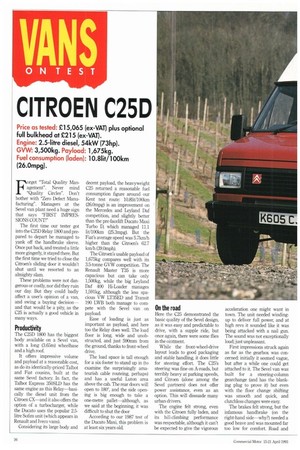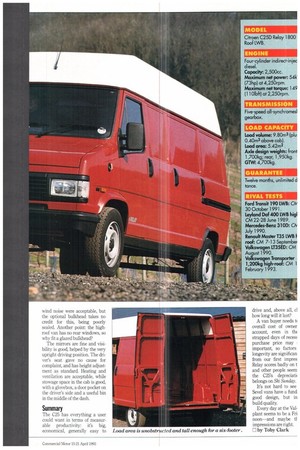CITROEN C25D
Page 28

Page 29

If you've noticed an error in this article please click here to report it so we can fix it.
Forget "Total Quality Management". Never mind "Quality Circles". Don't bother with "Zero Defect Manufacturing". Managers at the Sevel van plant need a huge sign that says "FIRST IMPRESSIONS COUNT!"
The first time our tester got into the C25D Relay 1800 and prepared todepart he managed to yank off the handbrake sleeve. Onceput back, and treated a little more gingerly, itstayed there. But the first time we tried to close the Citroen's sliding door it wouldn't shut until we resorted to an almighty slam.
These problems were not dangerous or costly, nor did they ruin our day. But they could badly affect a user's opinion of a van, and swing a buying decision— and that would be a pity, as the C25 is actually a good vehicle in many ways.
The C25D 1800 has the biggest body available on a Sevel van, with a long (3.65m) wheelbase and a high roof.
It offers impressive volume and payload at a reasonable cost, as do its identically-priced Talbot and Fiat cousins, built at the same Sevel factory In fact, the Talbot Express 350SLD has the same engine as this Relay—basically the diesel unit from the Citroen CX—and it also offers the option of a turbocharger, while the Dumto uses the popular 2.5litre Sofim unit (which appears in Renault and Iveco vans).
Considering its large body and decent payload, the heavyweight C25 returned a reasonable fuel consumption figure around our Kent test route: 10.81it/103km (26.0mpg) is an improvement on the Mercedes and Leyland Daf competition, and slightly better than the pre-facelift Ducato Maxi Turbo D, which managed 11.1 lit/100km (25.3mpg). But the Fiat's average speed was 51km/h higher than the Citroen's 62.7 km/h (39.0mph).
The Citroen's usable payload of 1,675kg compares well with its 3.5-tonne GVW competition. The Renault Master T35 is more capacious but can take only 1,500kg, while the big Leyland Daf 900 Hi-Loader manages 1,591kg, although the less spacious VW LT35ED and Transit 190 LWB both manage to compete with the Sevel van on payload.
Ease of loading is just as important as payload, and here too the Relay does well. The load floor is long, wide and unobstructed, and just 590mm from the ground, thanks to front-wheel drive.
The load space is tall enough for a six-footer to stand up in (to examine the surprisingly amateurish cable routeing, perhaps) and has a useful Luton area above the cab. The rear doors will open to 180°, and the side opening is big enough to take a one-metre pallet—although, as we said at the beginning, it was difficult to shut the door According to our 1987 test of the Ducat° Maxi, this problem is at least six years old. Here the C25 demonstrated the basic quality of the Sevel design, as it was easy and predictable to drive, with a supple ride, but once again, there were some flies in the ointment.
While the front-wheel-drive layout leads to good packaging and stable handling, it does little for steering effort. The C25's steering was fine on A-roads, but terribly heavy at parking speeds, and Citroen (alone among the Sevel partners) does not offer power assistance, even as an option. This will dissuade many urban drivers.
The engine felt strong, even with the Citroen fully laden, and its hill-climbing performance was respectable, although it can't be expected to give the vigorous acceleration one might want in town. The unit needed windingup to deliver full power, and at high revs it sounded like it was being attacked with a nail gun. The sound was not exceptionally loud; just unpleasant.
First impressions struck again as far as the gearbox was concerned: initially it seemed vague, but after a while one could get attached to it. The Sevel van was built for a steering-column gearchange (and has the blanking plug to prove it) but even with the floor change shifting was smooth and quick, and clutchless changes were easy The brakes felt strong, but the infamous handbrake (on the right-hand side—why?) needed a good heave and was mounted far too low for comfort. Road and
wind noise were acceptable, but the optional bulkhead takes no credit for this, being poorly sealed. Mother point: the highroof van has no rear windows, so why fit a glazed bulkhead?
The mirrors are fine and visibility is good, helped by the very upright driving position. The driver's seat gave no cause for complaint, and has height adjustment as standard. Heating and ventilation are acceptable, while stowage space in the cab is good, with a glovebox, a door pocket on the driver's side and a useful bin in the middle of the dash.
The C25 has everything a user could want in terms of measurable productivity: it's big, economical, generally easy to drive and, above all, cl how long will it last?
A van buyer needs to overall cost of owner account, even in di( strapped days of recess purchase price may important, so factors longevity are sign ifican from our first impres Relay scores badly on t and other people seem the C25's depreciatio belongs on Ski Sunday.
It's not hard to see Sevel vans have a fund good design, but in build quality.
Every day at the Valplant seems to be a Fri noon—and maybe tk impressions are right. 0 by Toby Clark
















































































